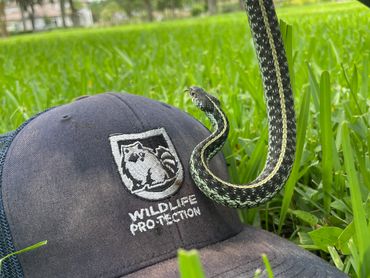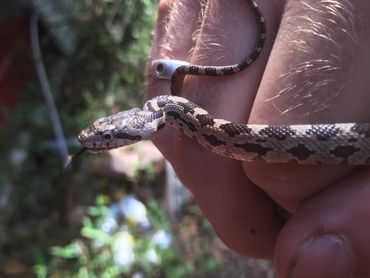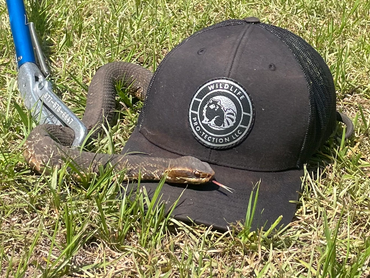Connect with Our Wildlife Experts Today! (904) 999-9241

Snake Removal & Prevention
Snakes are common pests that can pose a threat to your Family, Home, & Safety. These reptiles often seek shelter in yards, gardens, & homes in search of food & warmth. While some snakes are harmless, others can be venomous, posing significant risks to humans & pets.
Understanding & Preventing Snakes
Protect your Home & Property from snakes with expert solutions. Our comprehensive snake management services include inspection, exclusion, & prevention strategies tailored to your needs. Learn how to safeguard your home & prevent future intrusions with our humane methods.
How to Identify a Snake
If you encounter a Snake in Northeast Florida & can't identify it, it's best not always attempt identification yourself. Misidentifying snakes is common & can be dangerous. Leave it to the professionals at WILDLIFE PRO-TECTION. Maintain a safe distance & note key features like size, thickness, & overall color or patterns. These details will help our experts accurately identify the snake. If you can't remember specific features, simply note where you saw it & keep your eyes on it from a safe distance.
Key Details for Identification
Color & Patterns:
Head Shape Comparison:
Head Shape Comparison:
Look for specific markings like diamonds, crossbands, or distinctive colors that can help in identification. The Eastern Diamondback Rattlesnake features alternating light & dark diamond-shaped markings along its back, while the Cottonmouth is identified by its dark color with prominent crossbands.
Head Shape Comparison:
Head Shape Comparison:
Head Shape Comparison:
Venomous snakes often have a triangular-shaped head compared to the more rounded head of non-venomous snakes.
NOTE: The Coral Snake is venomous & has round pupils & head w/ hooked teeth, as opposed to fangs!
Size & Thickness:
Size & Thickness:
Size & Thickness:
Venomous snakes are generally thicker & longer than non-venomous ones. However, size alone is not always a reliable indicator, so observe other characteristics as well.
Eye Shape & Pupil
Size & Thickness:
Size & Thickness:
Venomous snakes often have elliptical pupils, whereas non-venomous snakes typically have round pupils. This feature can help differentiate between species.
Snake Color & Pattern Guide
Blotched patterns consist of irregular spots or patches. Note the size, shape, & color of the blotches for identification.
Example: The Florida Water Snake often has dark blotches on a lighter background, resembling the Cottonmouth but is non-venomous & more frequently found in freshwater habitats.
Head Shape Identification

Rounded Head (Non-Venomous) EXCEPT THE CORAL SNAKE
Non-venomous snakes like the Black Racer have a more rounded head, which lacks the pronounced jaw muscles seen in venomous species. This sleek head shape is common among non-venomous snakes in Northeast Florida.

Triangular Head (Venomous)
Venomous snakes in Northeast Florida, such as the Cottonmouth & Eastern Diamondback Rattlesnake, typically have a broad, triangular-shaped head. This head shape is due to the presence of venom glands located on either side of the head.

Snake Safety & Prevention
It's important to take precautions to prevent unwanted encounters with snakes, especially venomous ones. This includes keeping yards clean, sealing entry points on homes, & being cautious in snake-prone areas like long grass & swampy areas. If you encounter a snake, it's best to keep a safe distance & contact professional snake services for removal & advice. We are dedicated to providing effective solutions to keep your property snake-free & ensure your peace of mind!
Snake Removal & Prevention: Safeguard Your Property
At Wildlife PRO-TECTION, we specialize in snake removal & prevention services designed to protect your home & garden from unwanted wildlife intrusions. Here’s how we do it:
- Emergency Services: Our emergency snake hotline is available 24/7, providing immediate assistance to ensure your safety at any time. Our rapid response team is ready to handle any snake-related emergencies swiftly & effectively.
- High Success Rate: Our experienced team has a proven high success rate in removing snakes from residential & commercial properties. We utilize advanced techniques & equipment to ensure thorough & safe removal.
- Monthly Prevention Service: To prevent future invasions, we offer monthly inspections & the application of eco-friendly deterrents around your property. Our regular visits help maintain a snake-free environment year-round.
- Eco-Friendly Deterrents: Our natural deterrents are safe for the environment, pets, & humans. We provide sustainable solutions that keep snakes away without harming your loved ones or the ecosystem.
- Home Sealing & Prevention: In addition to removal & prevention deterrents, we also focus on long-term prevention by sealing up potential entry points around your home. Our experts will identify
& close gaps, cracks, & openings that snakes could use to enter your property, providing an additional layer of protection.
- Expertise & Peace of Mind: With our deep understanding of wildlife behavior & proven methods, you can rest assured that your property will remain free from snake intrusions. Trust Wildlife PRO-TECTION for reliable & effective snake control solutions.
Contact us today for Expert Snake Removal & Prevention
Preventive Measures:
Yard Maintenance:
Yard Maintenance:
Yard Maintenance:
- Keep Grass Trimmed: Regularly mowing your lawn & trimming vegetation reduces hiding spots for snakes. Short grass makes it easier to spot & deter snakes.
- Remove Debris: Clear your yard of leaf piles, wood piles, & other debris where snakes can hide. Keeping your yard tidy reduces the likelihood of snakes seeking shelter on your property.
- Manage Gardens & Landscaping: Maintain your garden by trimming bushes & shrubs away from your home. Consider using snake-repellent plants such as marigolds & lemongrass.
- Eliminate Food Sources: Snakes are attracted to areas with abundant food. Reduce rodent & insect populations by keeping your yard clean, storing pet food indoors, & using pest control measures.
Home Maintenance:
Yard Maintenance:
Yard Maintenance:
Schedule an inspections by a professional wildlife control service to identify & address potential snake attractants & help you take long term solutions:
- Seal Entry Points: Inspect your home for gaps, cracks, & holes in the foundation, walls, roof, & around doors & windows.
- Secure Vents & Chimneys: Install screens or caps on vents & chimneys to prevent snakes from entering your home through these openings.
- Repair Damaged Siding & Roofing: Regularly inspect & repair any damaged siding or roofing materials. Snakes can use these damaged areas as entry points.
Common Venomous Snakes in Northeast FL

Cottonmouth
Diamondback Rattlesnake
Diamondback Rattlesnake
Also known as the Water Moccasin, the Cottonmouth is a venomous snake commonly found near water bodies such as swamps, marshes, & rivers in Northeast Florida. It gets its name from the white, cotton-like interior of its mouth, which it displays when threatened. Cottonmouths are heavy-bodied & dark in color, often mistaken for non-venomous
Also known as the Water Moccasin, the Cottonmouth is a venomous snake commonly found near water bodies such as swamps, marshes, & rivers in Northeast Florida. It gets its name from the white, cotton-like interior of its mouth, which it displays when threatened. Cottonmouths are heavy-bodied & dark in color, often mistaken for non-venomous water snakes. Their venom can be dangerous, so it’s important to rely on professional removal services.

Diamondback Rattlesnake
Diamondback Rattlesnake
Diamondback Rattlesnake
The Eastern Diamondback Rattlesnake is the largest venomous snake in North America & is commonly found in Northeast Florida. Recognizable by its distinctive diamond-shaped patterns along its back & its characteristic rattle, this snake prefers dry, sandy areas such as pine forests & coastal dunes. The Eastern Diamondback's venom is highly
The Eastern Diamondback Rattlesnake is the largest venomous snake in North America & is commonly found in Northeast Florida. Recognizable by its distinctive diamond-shaped patterns along its back & its characteristic rattle, this snake prefers dry, sandy areas such as pine forests & coastal dunes. The Eastern Diamondback's venom is highly potent, making it crucial to seek immediate medical attention if bitten.

Coral Snake
Diamondback Rattlesnake
Pygmy Rattlesnake
The Eastern Coral Snake, known for its striking color pattern of red, yellow, & black bands, is a highly venomous species found in Northeast Florida. This elusive snake prefers wooded, sandy, or marshy areas & spends much of its time hidden under debris or in burrows. Despite its small size, the Eastern Coral Snake’s neurotoxic venom can
The Eastern Coral Snake, known for its striking color pattern of red, yellow, & black bands, is a highly venomous species found in Northeast Florida. This elusive snake prefers wooded, sandy, or marshy areas & spends much of its time hidden under debris or in burrows. Despite its small size, the Eastern Coral Snake’s neurotoxic venom can be life-threatening. For safe & effective coral snake removal & prevention, contact Wildlife
PRO-TECTION today.

Pygmy Rattlesnake
Diamondback Rattlesnake
Pygmy Rattlesnake
The Pygmy Rattlesnake is a small but venomous snake found throughout Northeast Florida. Often inhabiting pine forests, palmetto flatwoods, & around marshes, this snake has a distinctive rattle that is often too quiet to hear. Its coloration varies but typically includes shades of gray with dark, irregular blotches. Though its venom is les
The Pygmy Rattlesnake is a small but venomous snake found throughout Northeast Florida. Often inhabiting pine forests, palmetto flatwoods, & around marshes, this snake has a distinctive rattle that is often too quiet to hear. Its coloration varies but typically includes shades of gray with dark, irregular blotches. Though its venom is less potent than that of larger rattlesnakes, a bite from a Pygmy Rattlesnake can still be dangerous.
Contact us today.
Common Non-Venomous Snakes in Northeast FL

Rat Snake
Garter Snake
Black Racer
The Eastern Rat Snake, also known as the Black Rat Snake, is a common non-venomous snake in Northeast Florida. These snakes are excellent climbers & are often found in trees, barns, & attics. They play a crucial role in controlling rodent populations. Recognizable by their shiny black scales & white or yellowish bellies. Rat Snakes are harmless to humans.

Black Racer
Garter Snake
Black Racer
The Black Racer is another prevalent non-venomous snake in the region. Known for their speed & agility, these snakes are often seen darting through gardens, lawns, & forests. They are slender & usually black with a white chin & throat. Black Racers are harmless to humans & help control pest populations by feeding on insects, amphibians, & small mammals.

Garter Snake
Garter Snake
Garter Snake
The Eastern Garter Snake is a common non-venomous snake found in a variety of habitats, including gardens, forests, & wetlands in Northeast Florida. These snakes have distinctive yellow or white stripes running lengthwise along their greenish or brown bodies. Eastern Garter Snakes are harmless & beneficial as they help control insect & amphibian populations

Corn Snake
Garter Snake
Garter Snake
The Corn Snake, also known as the Red Rat Snake, is another non-venomous species common in Northeast Florida. These snakes are known for their vibrant orange or brownish-yellow coloration with large, reddish blotches bordered in black. Corn Snakes are excellent climbers & are often found in wooded areas, fields, & even suburban neighborhoods.
Did you Know?

Snakes Can Smell with Their Tongues Snakes use their tongues to pick up scent particles from the air & ground. By flicking their tongues in & out, they collect these particles & bring them to the Jacobson's organ (or vomeronasal organ) in the roof of their mouths, which helps them identify prey, predators, & mates.

Some Snakes Give Birth to Live Young
While many snakes lay eggs, some species, such as the Boa Constrictor & the Garter Snake, give birth to live young. This reproductive adaptation, known as viviparity, allows these snakes to thrive in cooler climates where incubating eggs would be challenging.

Snakes Have Flexible Jaws
Snakes can eat prey much larger than their head due to their incredibly flexible jaws. Their lower jaw is not rigidly attached to their skull & can stretch, allowing them to swallow animals whole. This ability enables them to consume a wide variety of prey, from small rodents to large birds.
Frequently Asked Questions About Snakes
Please reach us at info@wildlifepro-tection.com
if you cannot find an answer to your question.
Snakes are attracted to yards that offer food, water, & shelter. Common attractants include rodents, insects, tall grass, debris piles, & water sources like ponds or bird baths. Reducing these attractants can help keep snakes away.
No, not all snakes are dangerous. Many snakes are non-venomous & play a beneficial role in controlling rodent & insect populations. However, it is important to identify any snakes you encounter, as some may be venomous & pose a threat to humans & pets.
If you see a snake in your yard, it’s best to keep a safe distance & avoid disturbing it. Most snakes will move on their own if left alone. If you are concerned about its presence, contact a professional snake control service to safely remove it.
Identifying venomous snakes can be challenging & is best left to professionals. However, some general indicators include a triangular-shaped head, vertical pupils, & the presence of a heat-sensing pit between the eyes & nostrils. Familiarize yourself with the common venomous snakes in your area & if spotted, Call the Professionals.
Snake activity generally increases during the warmer months, from spring through fall. Snakes are cold-blooded & rely on external temperatures to regulate their body heat, making them more active during these periods.
Yes, snakes can enter homes, especially if there are gaps or openings in the foundation, walls, or around doors & windows. They may seek shelter indoors for warmth or in search of food. Sealing potential entry points & maintaining a tidy yard can help prevent this.
To prevent snakes from entering your home, seal any cracks & gaps in the foundation, walls, & around doors & windows. Install door sweeps & window screens, & ensure that vents & chimneys are properly screened. Keep your yard tidy & remove potential hiding spots to discourage snakes from coming near your home.
If you find a snake inside your home, remain calm & avoid approaching it. Close off the room, put a towel tightly secured at the bottom of the door if possible, & contact a professional snake control service to safely remove the snake. Do not attempt to handle or capture the snake yourself.
Contact Us Today!
Get in Touch for Professional Snake Control
If you suspect there's snakes in your yard/home or need assistance with prevention, contact WILDLIFE PRO-TECTION today. We offer effective snake control services to protect your home & ensure peace of mind.
Phone: (904) 999-9241
Email: info@wildlifepro-tection.com
Open today | 07:00 am – 10:00 pm |

Protect Your Home from Snake Intrusions!






This website uses cookies.
We use cookies to analyze website traffic and optimize your website experience. By accepting our use of cookies, your data will be aggregated with all other user data.